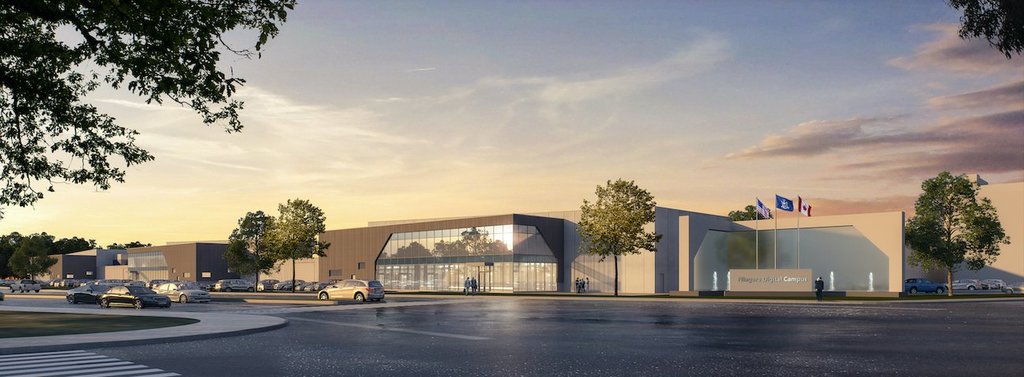By Frank Parlato
Mayor Robert Restaino will do anything to stop artificial intelligence from coming to Niagara Falls.
It’s a crusade.
He wants an arena — badly. But more than that, he wants to kill the competing vision: a state-of-the-art AI-powered data center campus that could put Niagara Falls on the map for 21st-century innovation.
His latest complaint? Noise. Not traffic, not emissions — just the phantom menace of server hums and imagined disruption. Never mind that modern data centers operate more quietly than the arena crowds he envisions.
The truth? It’s not really about noise. It’s about control.
Niagara Falls Redevelopment (NFR), in partnership with Urbacon Inc. — a Toronto-based developer renowned for building some of the world’s most advanced data infrastructure — has submitted a proposal to develop the $1.5 billion Data Center at Niagara Digital Campus.
The project would transform 53 acres in the heart of the city into a high-tech hub, creating hundreds of full-time jobs and attracting global tech tenants.
While the rest of the world moves forward, Restaino appears determined to drag Niagara Falls backward — toward a taxpayer-funded arena few asked for and even fewer will fill.
Let’s Put This Noise Nonsense to Bed — Literally
Mayor Restaino’s latest fiction is that you won’t be able to go to bed — because of the AI data center. This is political noise, not actual noise. And like most political noise, it’s not supported by science, facts, or common sense.
Noise Levels of the Niagara Digital Campus
The data centers at the Niagara Digital Campus, are not smokestacks and diesel engines. They are clean, ultra-quiet, and low-profile facilities—the kind that major cities around the world are begging to attract.
Here’s what the community should know:
• Whisper-Quiet by Design: Urbacon, one of Canada’s leading data center developers, engineers its facilities to emit no more than 55 decibels at the perimeter — roughly the sound of a household dishwasher or electric toothbrush.
• You Won’t Hear It: From the street, you’ll hear traffic before you hear a data center. Ambient street noise already drowns out anything the facility could emit.
• No Complaints, Ever: Urbacon has a spotless record. In decades of building and operating similar facilities across Canada and the U.S., they have never received a noise complaint.
New Noise Study Buries the Mayor’s Claim
As part of its updated Planned Unit Development (PUD) Petition, NFR commissioned an independent Noise Feasibility Study, which analyzed baseline conditions and modeled the center’s impact.
• Result #1: The data center meets or exceeds all legal standards under state and local law.
• Result #2: Even before the project is built, ambient noise levels in Niagara Falls already exceed certain outdated regulatory thresholds.
• These obsolete standards have triggered lawsuits against the city and expose just how arbitrary and restrictive local noise policies have become.
• Result #3: With basic mitigation techniques—including vegetative buffers, targeted equipment placement, and sound walls where necessary—the facility would keep noise to a minimum, often below street-level sound.
Mayor Restaino is using noise as a scare tactic to sabotage a $1.5 billion private investment that would create hundreds of full-time jobs in tech, construction, and maintenance. Meanwhile, he’s pushing for a taxpayer-funded arena—a facility built for cheering crowds, loudspeakers, concerts, and trucks backing up into loading bays.
If this were about noise, the arena would be the first thing off the table.
There Will Be a Buzz — And It’s the Sound of Opportunity
Aside from the fiction about noise. The real buzz will come from something much louder than a server rack: the hum of job creation, paychecks, and economic revival.
The Niagara Digital Campus, a $1.5 billion investment, isn’t just a tech project — it’s an economic engine, a job machine, and a rare shot at meaningful revitalization in a city long overdue for success.
Massive Job Creation Over Two Decades
A comprehensive 2025 analysis by MRB Group, a nationally respected economic development consultant, projects the following outcomes:
• 19,238 job-years over 20 years — including construction, operations, and support industries.
• That’s an average of 962 jobs per year, every year, for two decades.
• These jobs are projected to generate $1.6 billion in total wages, or $83.1 million annually for local workers.
During Construction Alone: A Local Boom
• More than 6,000 construction jobs, many going to local union trades.
• $1.3 billion in local construction spending, including:
• $757 million in union labor
• $516 million in local material purchases
• Construction is expected to generate:
• 6,084 direct jobs
• 2,403 indirect jobs
• $619.2 million in wages
• $1.7 billion in local economic activity
This is real economic development — not just studies, speeches, or loud and wishful thinking.
Permanent, High-Paying Jobs for the Long Term
Once operational, the Niagara Digital Campus will generate:
• 771 permanent jobs:
• 550 direct high-tech, security, and support roles
• 221 indirect jobs in the local economy
• $45 million in annual wages from the permanent jobs
• $276 million in total economic activity each year
These aren’t gig jobs or low-wage service positions. They are career-level roles in a future-forward industry — data security, IT infrastructure, electrical and HVAC engineering, system maintenance, facilities management, and more.
Ripple Effects Across the Community
This means jobs for:
• Electricians
• Plumbers
• Ironworkers
• Landscapers
• Concrete and steel contractors
• Local restaurants, truckers, hardware suppliers
• …and the next generation of young people who want to stay in Niagara Falls and build a life.
While Mayor Restaino is chasing a 7,000-seat taxpayer-funded arena that might employ a few dozen ushers and concession workers part-time, the Digital Campus would create hundreds of full-time careers—with real benefits, real salaries, and long-term stability.
That’s the buzz. That’s the future. And if you listen closely, you can already hear it coming.
